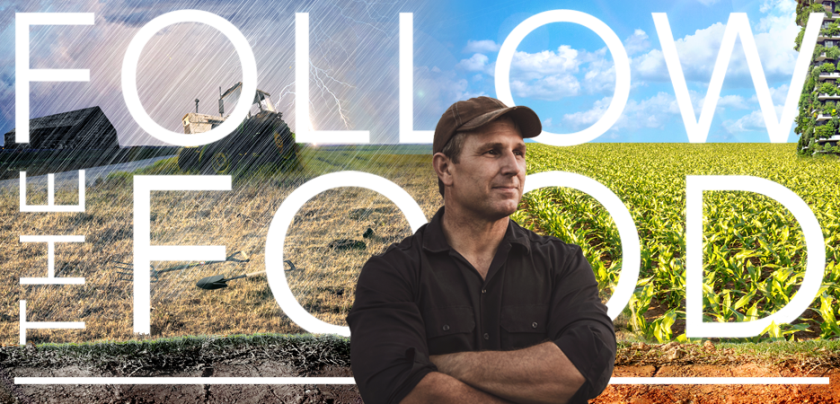For millions of people around the world, food security is far from guaranteed. Not knowing where our next meal will come from is a problem that could affect any one of us, from the poorest to the richest nations.
With the UN declaring the latest IPCC climate report a ‘code red for humanity’, Follow the Food looks at what the key threats are to our food systems are, from extreme weather to inequality, and what our brightest minds, governments, big business and stewards of our land are doing to turn the tide in the fight for food security.
In the first episode of the BBC World News and BBC.com series, Follow the Food, presenter and renowned ethnobotanist, James Wong, finds out how food security is measured using the Global Food Security Index and looks at what this means for different communities across the world.
Global Food Security Index
For the last decade, The Economist Group has been producing a Global Food Security Index to help nations understand what it means. The Global Food Security Index (GFSI) measures food security across 113 countries, using 59 indicators. It takes into account four categories: affordability, availability and quality & safety. This year, a fourth category – natural resources & resilience – has been incorporated into the main index to assess how climate change is impacting food security.
Affordability
The first category measured on the index is GFSI is affordability, defined as the ability of consumers to purchase food, their vulnerability to price shocks and the presence of programmes and policies to support customers when shocks occur. But, protecting this aspect of food security isn’t as simple as just producing cheaper food. Many of those living in extreme poverty actually work in the food system – meaning, ironically, that the people producing our food are often the least able to afford to eat.
Women in farming are disproportionately affected by poverty – with many in the developing world denied access to land rights, training and finance. Research around the world has consistently shown in development projects that, if women earn a certain amount, more of that actually goes to their family than if men are paid the same amount.
CARE, a humanitarian organisation fighting global poverty, are trying to close the gender gap with their ‘She Feeds the World’ initiative.
Explains Michelle Nunn, President and CEO at CARE: “Empowering female farmers is the difference between achieving global food security and not achieving global food security. We know from the stats, and from the research, that we have a huge leverage with women. When their incomes increase, you see an exponential leverage within families because they are proportionally spending more on their children, their nutritious needs, their schooling needs, and so you not only have the capacity to lift up the woman but her family, the children and, over time, the community.”
A fairer deal for female farmers would mean better productivity and improved incomes – both of which add up to more affordable food and so better food security.
Availability
To be fully food secure we also need to take into account availability which, according to the GFSI, is the sufficiency of the national food supply, the risk of disruption, the national capacity to disseminate food and research efforts to expand agricultural output.
Don’t assume this is only an issue for nations in the developing world, as some of the planet’s richest countries are having to face up to potential vulnerabilities in their food supplies. For example, last year, Singapore slipped from number one on the global food security index to 19th, but they’re taking steps to make the country more resistant to shocks. The Singapore Food Agency has set the country a target to produce thirty percent of its nutritional needs by 2030, and technology is at the heart of the plan.
Said Goh Wee Hou of the Singapore Food Agency: “Singapore is a very small country. We don’t have the luxury of having large tracts of land to grow food extensively. As a result, we currently import over 90 percent of our food supplies from overseas sources. When COVID-19 accelerated in 2020, we saw the overseas supply chains have the potential to be disrupted. Some countries went into lockdown, ports were shut down, airlines were grounded, some countries even banned exports of certain food items for a period of time. We need to maximise the amount of food we produce out of every hectare we have and we think that technology can really play a big role there.”
But it’s not just high-rise, high-density countries of the developed world that have been relying on food imports to sustain themselves. Produce is constantly moving around the world to plug gaps in nations where demand outstrips national production.
In Kenya, ninety percent of rice consumed is imported, so the government is driving an ambitious program to super-charge local production of the vital staple crop. By 2030, they’re aiming to be completely self-sufficient with rice, by improving farming techniques and using new varieties, which are bred to be higher yielding and more resistant to disease.
Affordability and availability are crucial measures and, when it comes to food security, one threat looms larger than any other – climate change.
Euskirchen in Germany is a region that’s typically known for its mild climate, characterised by very few extreme weather events. But, recently, unprecedented rainfall caused flash floods that ripped through leaving devastation in their wake. Over 180 people died in Germany as a result of the floods, and the tragedy is just one of a series of climate disasters all over the world this year – from North America and China, to all across Europe. Not only are they a direct threat to life, but also to our food supplies.
During the floods in Euskirchen, many farmers had their fields wrecked, with top soil being washed away and crops being contaminated. And, whilst farmers are notoriously tough and incredibly resilient, even they are left feeling powerless.
The 2021 intergovernmental panel on climate change states ‘there’s no going back from some changes in the climate system. However, some changes could be slowed and others could be stopped by limiting warming’.
Natural resources and resilience
Natural resources and resilience are now at the forefront of the global food security index, and fighting food insecurity, caused by climate change, will clearly require immediate action from the biggest players in the food industry.
Unilever own some of the world’s most famous brands, operate in 190 countries, and two and a half billion consumers use their products every day. They’ve recently committed to investing one billion euros to help fight climate change across the food chain.
Explained Marc Engel, Chief Supply Chain Officer at Unilever: “I’m a scientist and I believe we have to follow the science. And the science is pretty clear that we are already late but, if we don’t do it now, we are going to be too late. In blunt jargon people call the food system ‘broken’: it is very inequitable and it is very inefficient. Unilever has about a 4-million-hectare footprint – that’s about a third of the size of England – that’s our agricultural footprint that we need to make all of our products. That is sizable and agriculture has a big role to play in the achievement of the Paris climate accord – it is a problem but it can also be the solution. Farmers and small holders have a very important role to play – they’re the stewards of the land, they can make the difference: either in a good way or in a bad way.”
Unilever is providing financial incentives to its suppliers who use regenerative farming practices, like Kenny Sutter a farmer in Iowa and his family who grow soy beans for mayonnaise.
Said Sutter: “This farm is a second-generation farm. My father came here in ’63 and he started farming here and I’ve got grandchildren coming up that I want to be able to hand a product to them that was at least as good, if not better, as when I got it handed to me by my father. There’s no doubt about it; we’ve seen the climate changing for a lot of years and I think it’s going to continue to change but yet we’ve got to continue to change with it to try to do the best job that we possible can with what’s in front of us.”
In between harvests, Kenny plants cover crops to improve soil health and drainage. There’s hope that regenerative agriculture cannot just protect against extreme weather, but also fight climate change itself, the upshot of which would be better food security.
Quality & Safety
For real global food security, we need quality as well as quantity. It’s estimated that 23 million people in the US alone live in food deserts – areas without access to fresh, healthy food.
Emmy-award-winning broadcaster and pioneering educator, Stephen Ritz, witnesses the consequences every day at Hunts Point in the Bronx. Stephen and his green Bronx machine programme aim to help cure food deserts and poor nutrition through education. They’ve created more than 500 classrooms in urban schools where hundreds of bags of groceries are grown and distributed among the food insecure. And their work has become part of the US core curriculum used across 50 states.
Said Ritz: “Right here are some of the largest food insecurity issues, some of the largest health related problems due to nutrition, some of the longest histories of intergeneration poverty, chronic unemployment and poor graduation. Two miles away is the gleaming skyline of Manhattan. Not one mile away from where we stand is the largest food distribution centre in the world, and yet to think that every bit of food that’s disseminated from that market is not available right here but can be found out there, out there, out there, and out there, to me is absolutely mind numbing. I believe that good food is a basic human right.
“This neighbourhood was in crisis before we got here, but now we’ve got collard greens, we’ve got broccoli, it is raining egg plants. It’s amazing – we are literally farming under the New York City subway. We are calling attention to a problem and showing that locally grown solutions can scale and inspire others to greatness. Post Covid, the opportunity to create blended communities, walkable communities, shared communities, pop up shops, all kinds of innovation is absolutely doable. And it’s got to happen: climate change demands that, overpopulation demands that, limited natural resources demand that. So, I like to think we’re at the cutting edge of saving the world, right here in a little humble corner of The Bronx.”
Affordability, availability, resilience, and quality: all huge challenges facing global food security but can they be conquered? With so many different challenges coming from different angles, all with different solutions, some of which we can control some of which we can’t control, should we be optimistic?
Says Dr Agnes Kalibata, UN Secretary-General’s Special Envoy to the 2021 Food Systems Summit: “I’m extremely optimistic for a number of reasons. The first is our ability to innovate. Just think about how we turned the corner back 50 years ago; we innovate, we find a way of feeding billions of people. That’s what happened. So even though we have challenges, it is within our capabilities to change how the world is working today. The question is do we have a significant enough will in the right places to be able to do it?” For more or to watch the episode Follow the Food: The Fight for Food Security in full, visit https://www.bbc.com/followthefood/



